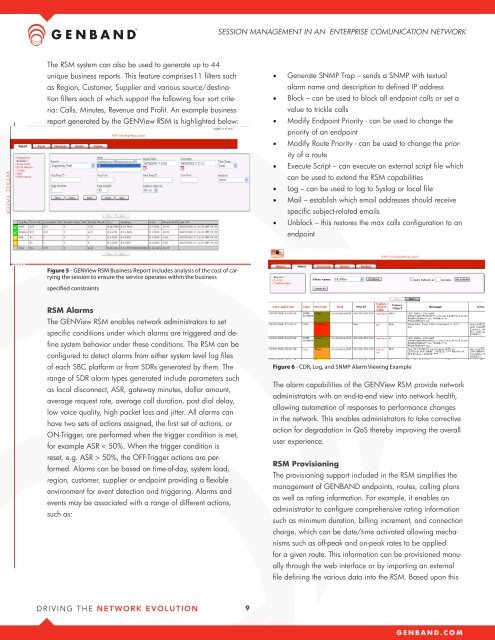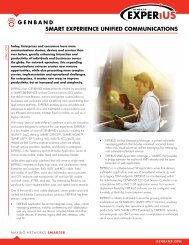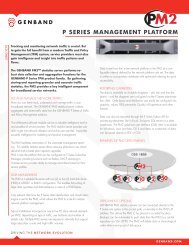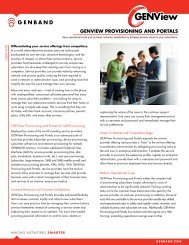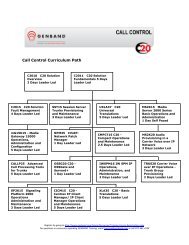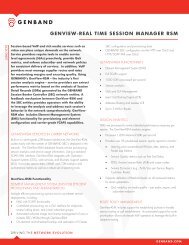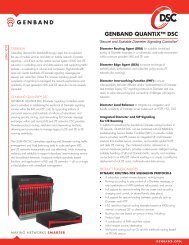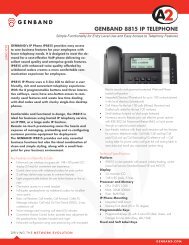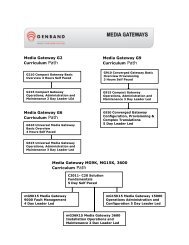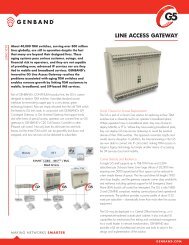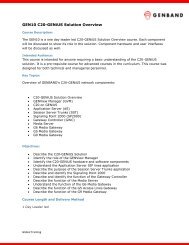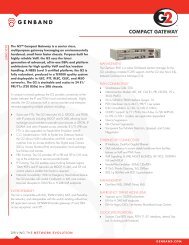session management in an enterprise comunication ... - Genband
session management in an enterprise comunication ... - Genband
session management in an enterprise comunication ... - Genband
You also want an ePaper? Increase the reach of your titles
YUMPU automatically turns print PDFs into web optimized ePapers that Google loves.
SESSION MANAGEMENT IN AN ENTERPRISE COMUNICATION NETWORK<br />
The RSM system c<strong>an</strong> also be used to generate up to 44<br />
unique bus<strong>in</strong>ess reports. This feature comprises11 filters such<br />
as Region, Customer, Supplier <strong>an</strong>d various source/dest<strong>in</strong>ation<br />
filters each of which support the follow<strong>in</strong>g four sort criteria:<br />
Calls, M<strong>in</strong>utes, Revenue <strong>an</strong>d Profit. An example bus<strong>in</strong>ess<br />
report generated by the GENView RSM is highlighted below:<br />
• Generate SNMP Trap – sends a SNMP with textual<br />
alarm name <strong>an</strong>d description to def<strong>in</strong>ed IP address<br />
• Block – c<strong>an</strong> be used to block all endpo<strong>in</strong>t calls or set a<br />
value to trickle calls<br />
• Modify Endpo<strong>in</strong>t Priority - c<strong>an</strong> be used to ch<strong>an</strong>ge the<br />
priority of <strong>an</strong> endpo<strong>in</strong>t<br />
• Modify Route Priority - c<strong>an</strong> be used to ch<strong>an</strong>ge the priority<br />
of a route<br />
• Execute Script – c<strong>an</strong> execute <strong>an</strong> external script file which<br />
c<strong>an</strong> be used to extend the RSM capabilities<br />
• Log – c<strong>an</strong> be used to log to Syslog or local file<br />
• Mail – establish which email addresses should receive<br />
specific subject-related emails<br />
• Unblock – this restores the max calls configuration to <strong>an</strong><br />
endpo<strong>in</strong>t<br />
Figure 5 - GENView RSM Bus<strong>in</strong>ess Report <strong>in</strong>cludes <strong>an</strong>alysis of the cost of carry<strong>in</strong>g<br />
the <strong>session</strong> to ensure the service operates with<strong>in</strong> the bus<strong>in</strong>ess<br />
specified constra<strong>in</strong>ts<br />
RSM Alarms<br />
The GENView RSM enables network adm<strong>in</strong>istrators to set<br />
specific conditions under which alarms are triggered <strong>an</strong>d def<strong>in</strong>e<br />
system behavior under these conditions. The RSM c<strong>an</strong> be<br />
configured to detect alarms from either system level log files<br />
of each SBC platform or from SDRs generated by them. The<br />
r<strong>an</strong>ge of SDR alarm types generated <strong>in</strong>clude parameters such<br />
as local disconnect, ASR, gateway m<strong>in</strong>utes, dollar amount,<br />
average request rate, average call duration, post dial delay,<br />
low voice quality, high packet loss <strong>an</strong>d jitter. All alarms c<strong>an</strong><br />
have two sets of actions assigned, the first set of actions, or<br />
ON-Trigger, are performed when the trigger condition is met,<br />
for example ASR < 50%. When the trigger condition is<br />
reset, e.g. ASR > 50%, the OFF-Trigger actions are performed.<br />
Alarms c<strong>an</strong> be based on time-of-day, system load,<br />
region, customer, supplier or endpo<strong>in</strong>t provid<strong>in</strong>g a flexible<br />
environment for event detection <strong>an</strong>d trigger<strong>in</strong>g. Alarms <strong>an</strong>d<br />
events may be associated with a r<strong>an</strong>ge of different actions,<br />
such as:<br />
Figure 6 - CDR, Log, <strong>an</strong>d SNMP Alarm View<strong>in</strong>g Example<br />
The alarm capabilities of the GENView RSM provide network<br />
adm<strong>in</strong>istrators with <strong>an</strong> end-to-end view <strong>in</strong>to network health,<br />
allow<strong>in</strong>g automation of responses to perform<strong>an</strong>ce ch<strong>an</strong>ges<br />
<strong>in</strong> the network. This enables adm<strong>in</strong>istrators to take corrective<br />
action for degradation <strong>in</strong> QoS thereby improv<strong>in</strong>g the overall<br />
user experience.<br />
RSM Provision<strong>in</strong>g<br />
The provision<strong>in</strong>g support <strong>in</strong>cluded <strong>in</strong> the RSM simplifies the<br />
<strong>m<strong>an</strong>agement</strong> of GENBAND endpo<strong>in</strong>ts, routes, call<strong>in</strong>g pl<strong>an</strong>s<br />
as well as rat<strong>in</strong>g <strong>in</strong>formation. For example, it enables <strong>an</strong><br />
adm<strong>in</strong>istrator to configure comprehensive rat<strong>in</strong>g <strong>in</strong>formation<br />
such as m<strong>in</strong>imum duration, bill<strong>in</strong>g <strong>in</strong>crement, <strong>an</strong>d connection<br />
charge, which c<strong>an</strong> be date/time activated allow<strong>in</strong>g mech<strong>an</strong>isms<br />
such as off-peak <strong>an</strong>d on-peak rates to be applied<br />
for a given route. This <strong>in</strong>formation c<strong>an</strong> be provisioned m<strong>an</strong>ually<br />
through the web <strong>in</strong>terface or by import<strong>in</strong>g <strong>an</strong> external<br />
file def<strong>in</strong><strong>in</strong>g the various data <strong>in</strong>to the RSM. Based upon this<br />
9


